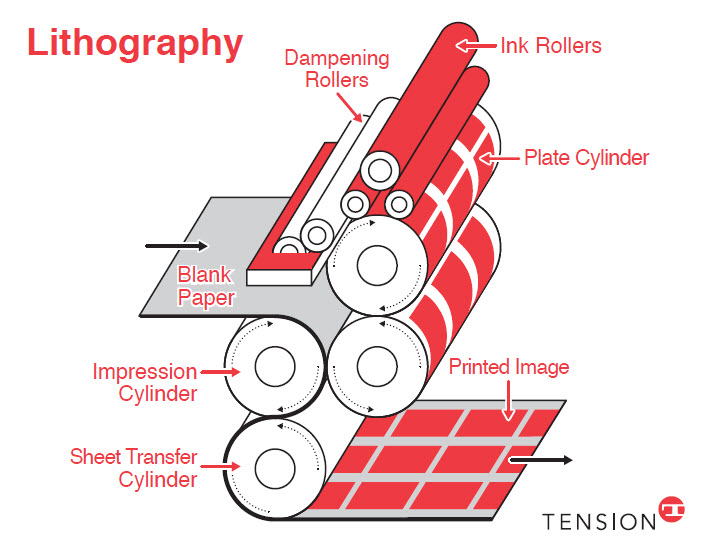A Comprehensive Overview to Recognizing Litho Printing Methods
The world of litho printing, a technique originating from the late 18th century, is a remarkable blend of background, technology, scientific research and art. Keep with us as we trip right into the exciting world of litho printing.
The Historical Advancement of Litho Printing
The historic trajectory of litho printing, a pivotal innovation in the realm of communication, is an exciting story of human resourcefulness. Birthed in the late 18th century by Alois Senefelder, this strategy was at first an affordable approach of releasing staged works. Lithography, stemmed from the Greek words for 'rock' and 'to write', made use of a smooth rock surface to move images onto paper. The procedure evolved with the development of the rotating press, which significantly raised efficiency (litho printing). In the 20th century, the innovation of countered lithography changed the market, permitting for mass manufacturing of high-quality prints. Each stage of litho printing's development showcases mankind's unrelenting pursuit of effectiveness and high quality in aesthetic interaction.
Decoding the Scientific Research Behind Litho Printing Inks
Progressing in the exploration of litho printing techniques, the focus now shifts to the scientific research behind litho printing inks. The make-up of these inks, their drying out procedure, and shade mixing methods develop the foundation of this complex art form. Understanding these components is essential to grasping the craft and accomplishing the preferred print results.
Composition of Litho Inks
In lithographic printing, the basic function of litho inks can not be overemphasized. Pigments, the color-providing components, are finely ground bits put on hold in the automobile, a fluid that lugs the pigment onto the printing surface area. Each part plays a crucial component in the last print's high quality, making the exact formulation of litho inks a detailed scientific research.
Ink Drying Process
From the structure of litho inks, focus turns to the interesting process of ink drying. The drying procedure is important, as it influences the final print's high quality and longevity. Two primary methods are made use of in litho printing: oxidative drying out and absorption. Oxidative drying includes the ink reacting with oxygen in the air to create a hard, completely dry film. This method supplies a durable surface, however can be slower contrasted to absorption. Absorption, on the other hand, entails the ink leaking right into the paper fibers, which is a faster process yet can cause much less vivid colors. The choice in between these approaches depends on aspects such as print speed needs, the paper type made use of, and the desired surface.
Shade Combining Strategies
While the drying out process plays a key role in litho printing, the science of shade blending methods holds equivalent significance. The science behind litho printing inks also takes right into account the openness of the ink, which influences exactly how colors overlay and mix.
The Art and Layout Aspects in Litho Printing
Litho printing takes a breath life right into art and layout via its unique aspects. Litho printing fits a range of shades, enabling musicians to produce dynamic and lively prints. This mix of accuracy and versatility makes litho printing a recommended option for many musicians and developers.
Modern Applications of Litho Printing Techniques
Litho printing techniques have located comprehensive usage in the modern-day industrial sector. Its impact and significance proceed to expand with the advent of new innovations and innovations in the field. This area will discover these contemporary applications and the transformative duty they play in the printing market.
Commercial Litho Printing Utilizes
In today's electronic age, one may question the relevance of standard printing approaches. Yet, litho printing continues to be a crucial part of the business sector. High-volume printing jobs, such as the production of books, newspapers, and product packaging, depend on litho printing for its capability to deliver premium image quality and price performance. The process, which entails moving a tattooed picture imp source from a plate onto a rubber covering and after that to the printing surface area, uses try this out unequaled uniformity. This makes it ideal for jobs calling for a huge print run. Litho printing likewise gives a wide shade range, above that of digital printing. This makes it the go-to selection for projects that require vibrant, top notch shade reproduction.
Advancements in Litho Printing
Pushing the borders of standard strategies, modern innovations have actually fueled a host of innovations in litho printing. One prominent advancement is digital litho printing, which integrates the merits of digital technology with litho's high-quality result. These developments highlight the long-lasting importance of litho printing in the contemporary globe.
Checking out the Refine of Litho Printing: Step by Step

Difficulties and Solutions in Contemporary Litho Printing

Regardless of the precision and practice that litho printing happily supports, it is not without its set of contemporary difficulties. Digital litho printing enables for affordable short runs and very easy modification, attending to the problem of variable data. Thus, while there are challenges, the litho printing industry is proactively adapting to meet them head-on, guaranteeing its importance in the future.
Final thought
To conclude, litho printing, with its rich history and clinical ins and outs, holds a considerable location in the print market. As the guide discloses, it's a synthesis of art and technology, with modern innovations guaranteeing its significance. The sector encounters challenges that require cutting-edge remedies, with an emphasis on automation and sustainability. The future of litho printing pivots on its ability to adapt to these altering demands, attesting its long-lasting worth in a developing market.
